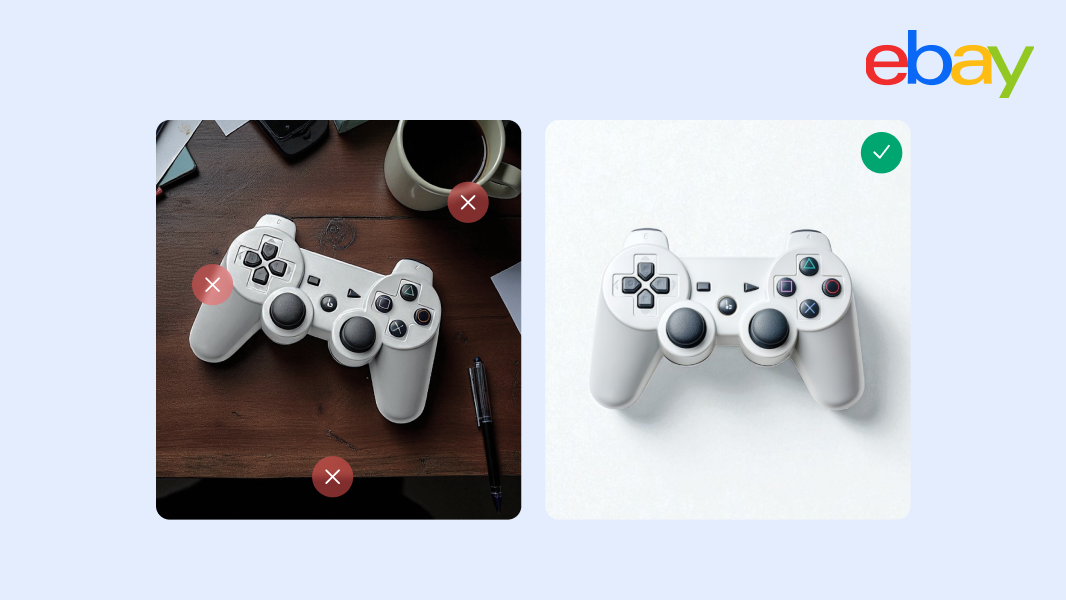How Gen AI can impact image workflows for marketplaces
From the need to save time and money to the imperative of automating complex multi-stakeholder processes, ecommerce marketplaces are facing a multitude of challenges today. There’s a pressing need to innovate the experiences of the sellers using an ecommerce platform and their shoppers, with executives expecting marketplaces to adopt AI in order to stand out amongst competitors.
The change is happening rapidly. In the past couple of years, AI has seen an explosion in adoption by the consumer market and the B2B world. According to the Stanford Artificial Intelligence Report Index 2023, global AI investment reached nearly $92 billion in 2022. Businesses across industries are harnessing the power of AI to scale their operations, increase revenue, and improve customer experiences. The integration of AI—particularly through APIs like Photoroom's—offers a solution to the problems of scalability and resource management.
In this article, we'll dive into the different ways AI can revolutionize image workflows for marketplaces. We'll explore how AI technologies can address the challenges of efficiency, cost-effectiveness, and innovation in ecommerce platforms.
What is AI?
Artificial Intelligence, or AI, is an emerging technology that encompasses a spectrum of functions like machine learning, deep learning, and natural language processing. AI empowers systems to analyze data, make decisions, and automate tasks that traditionally require human input. Generative AI—a subset of AI—is a machine learning method that learns valuable patterns about content from datasets that form its training foundation, using it to generate brand-new and original, realistic artifacts (like text and images).
Gartner predicts that by 2025, generative AI will account for 10% of all data produced. This underscores the growing importance of AI, especially for ecommerce marketplaces that process large amounts of customer data. Today, AI is the driving force behind personalized product recommendations, chatbots, fraud detection, and data analytics. The evolution of AI promises even more sophisticated technology in the years to come, with AI poised to play an increasingly pivotal role in shaping the ecommerce landscape.

What is AI photo editing?
AI photo editing, in turn, is technology that leverages artificial intelligence to automate and enhance different aspects of image processing like background removal, image resizing, text addition, and more. This gives end users the ability to generate or modify images based on prompts, opening up a whole world of creative possibilities for creating visuals.
Here are some examples of photo editing tasks that AI photo editing can achieve:
Automated background removal: This allows ecommerce sellers to effortlessly eliminate backgrounds from images to isolate objects, resulting in professional product visuals. For example, Photoroom’s background remover swiftly and accurately separates subjects from backgrounds, simplifying the image editing process for users.
Instant backgrounds: The ability to instantly change the background of an image, offering users the flexibility to place subjects in various settings. For example, Photoroom’s Instant Backgrounds provides an extensive library of backgrounds, allowing users to easily transport their subjects to different environments with just a few clicks.

Instant shadows. The automatic addition of realistic shadows to images, enhancing their depth and realism. Photoroom's instant shadow feature intelligently generates and adjusts shadows to match the lighting conditions of the subject and background, ensuring a professional and natural look.
Processing images in batches. This time-saving function allows marketplace vendors to efficiently resize, crop, and optimize a large number of images simultaneously, ensuring they meet platform-specific requirements or design preferences. Photoroom simplifies this process with its batch image processing feature, allowing users to apply consistent edits to multiple images with ease.
Seamless text and logo integration. Another essential AI photo editing task that enables users to incorporate text, watermarks, or logos into images to maintain a unified brand presence across various channels. Photoroom's add text to photo feature offers a user-friendly interface for customizing and placing text or logos on images, empowering users to create cohesive branding effortlessly.
What’s Photoroom’s API?
The Photoroom API enables automatic background removal and batch image editing, streamlining image processing tasks. It efficiently separates subjects from backgrounds, making it a useful tool for various image-related tasks. At the heart of Photoroom's background removal API is advanced AI technology trained on a wide range of images, giving users precise and high-quality background removal.
Here's an example of how our technology can handle the most tricky images:

The benefits of adopting AI technology for marketplaces
Product images are incredibly important in shaping the ecommerce customer journey. In this survey by ergonode, 87.6% of respondents considered product images as key elements of their shopping experience.
On top of staying on top of customer expectations, brands and retailers have to manage resources dedicated to asset production. Product photography processes are costly, with custom creative photoshoots ranging from $500 to $4,000 per day, including the cost of a photographer, studio and models. This restricts an ecommerce store-owner’s ability to scale and create personalized experiences for their shoppers. To solve this, ecommerce marketplaces can adopt AI photo editing tools, which allows their sellers or resellers to simplify and automate the creative process while opening new avenues for product customization and personalization.
Let's dive into some instances illustrating how AI can fundamentally alter the selling experiences of ecommerce sellers, as well as the shopping experiences of their customers.
A more streamlined asset production process
Marketplaces run slimmer margins than their first-party commerce counterparts. A brand that sells its own product can make margins upwards of 70%, yet marketplace transactions have margins closer to 5-20% (Statista). Marketplaces are constantly searching for ways to optimize image workflows and reduce costs. They want high quality images but paying for photographers and outsourcing their image editing workflows can get expensive.
With AI photo editing, marketplaces reduce the costs, back-and-forth communication, time delays, and quality concerns associated with photo editing outsourcing. This scalability ensures that marketplaces can meet the demands of their sellers and customers without compromising on quality.
Intondo, a marketplace for art, design and vintage furniture, integrated the Photoroom API into its tech stack and reported saving 15 seconds per image approval. This freed them to spend more time on tasks that can’t be automated, like sourcing and creating more listings.
Watch their story below:
How Photoroom helps Intondo edit images in just 15 seconds
A consistent visual brand experiences
AI maintains a consistent image style, aligning all visuals with a marketplace's branding guidelines. This consistency strengthens the marketplace's identity and provides sellers with a standardized platform to showcase their products.
Achieve lower operational costs
By automating photo editing tasks, ecommerce marketplaces can significantly reduce operational costs and streamline asset production processes. This cost-effective approach allows marketplaces to offer competitive pricing to sellers while maintaining profitability.

By eliminating the need to hire photographers or outsource image editing, Selency—an online marketplace for secondhand furniture and decor—saw that images processed by the Photoroom API cost 89% less than their previous solution. This includes savings on photographer fees, editing service costs, and the associated logistics.
Increase conversion rates and sales
AI allows marketplaces to create multiple image variations and mockups for products, giving customers a comprehensive view of each item. Research by Ebay Research Labs found that listings with one image had twice the conversion rates of listings with zero images. Conversion rates doubled again for listings with two images versus only one. Offering a variety of product images enables customers to make more informed purchase decisions.
Gain a competitive edge
AI enables marketplaces to stay competitive by offering advanced photo editing and creation services, reducing seller workload and enhancing their experience. This attracts more sellers to the platform and fosters growth–signaling to investors a dedicated commitment to offering cutting edge technology to customers.
Get faster inventory turnover
Marketplaces rely on metrics like the percentage of goods sold after 7 and 30 days, which puts them in a highly competitive environment where time-to-market can make a significant difference to the bottom line. Rapidly listing new products and updates is crucial for staying competitive and meeting customer demands. Marketplaces can introduce new products and trends to the market faster, keeping their offerings fresh and appealing.
By integrating an image editing AI, e-commerce marketplaces can use advanced AI technology, like the Photoroom API, to streamline their product listing workflows. By integrating an AI solution, marketplaces can automate image editing tasks, including background removal, resizing, and branding, allowing them to list products more quickly and efficiently.
Selency, facing a 24-hour image processing delay from their outsourced workflow, sought a faster solution. After extensive vendor research and image testing, they integrated the Photoroom API into their backend to automate background removal before product moderation. Now, when sellers publish products, Selency's moderation process includes a call to the Photoroom API for recentering, resizing, and adding a white background. This enhancement lets moderators preview final product images much more quickly, providing a competitive edge and rapid response to market trends.
Lower product return rates
Customers benefit from clear, professionally edited product images that provide an accurate representation of items for sale. A study by Invesp found that 22% of ecommerce shoppers returned products because they looked different than the product images online. Offering multiple product images improves buyers’ shopping experiences and reduces uncertainty, leading to lower return rates.
Online sales depend on providing authentic, high-quality images to prevent administrative costs and reduce returns rates. With online sales, it’s important to have many images to provide an authentic view of the item on sale. These marketplaces want images to be brand appropriate, that is, contain no explicit content or be poor quality. They want the images to look like they were taken by a professional photographer.
AI can ensure that images are of high quality and meet brand standards, effectively reducing costs associated with customer inquiries and returns. Photoroom’s API, for example, can deliver consistent product centering and padding, white or custom backgrounds and impeccable brightness—no photographer costs or manual effort required.
Reasons to use the Photoroom API
With our API, you can effortlessly separate the subject from the background, creating stunning images that will captivate your audience.
But what sets Photoroom's API apart from the competition? Read on to discover why our background removal API is the best choice for all your image editing needs.
Set up in as little as an hour: We understand that time is of the essence for developers, which is why our API is designed with ease of integration in mind. With just a few lines of code, you can quickly integrate Photoroom's background removal API into your app or website. Our comprehensive documentation and dedicated support team make the process hassle-free, allowing you to focus on what matters most: enhancing your product.
Fast and reliable: With over 3 million images processed per day and a median latency below 250 milliseconds worldwide, our API is built to handle the most demanding workloads across the world. You can count on it to deliver results quickly and reliably so you can focus on what matters—meeting your business goals.
Accuracy: Our API renders high-quality images at scale. We offer a 100% money-back guarantee to cover situations when our results don’t meet your quality criteria and if you find a photo editing API that provides better results than ours.
Competitive pricing: We believe in offering our customers the best value for their money. Our background removal API is competitively priced, ensuring that you receive the highest quality product without breaking the bank. For consumer-facing apps, we offer flexible pricing options (starting from $0.01) in exchange of attribution, so that you can enjoy the benefits of our cutting-edge technology while staying within your budget.
Dedicated customer support: Our team of engineers is available to assist you with any questions or concerns you may have about our background removal API. Our support team works to ensure that you have a smooth and enjoyable experience using our API.
AI will continue to evolve and raise the bar for automated content creative, personalized experiences, and streamlined processes. It will continue to empower businesses so they can generate, edit and publish realistic product photography at scale. As this technology advances, we can expect even more innovative applications of AI that will help businesses stay competitive in the ecommerce landscape.




Design your next great image
Whether you're selling, promoting, or posting, bring your idea to life with a design that stands out.

















